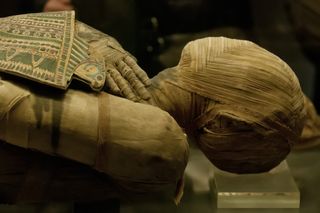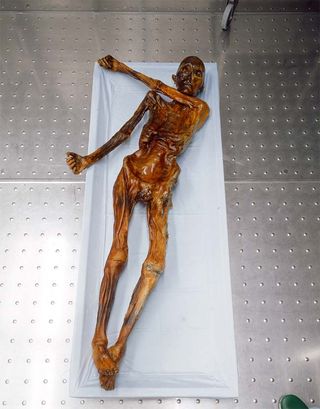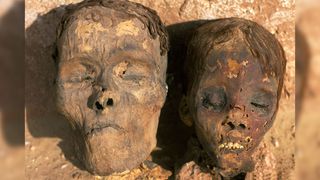Mummification: The lost art of embalming the dead
Mummification, or the process of preserving the dead, was once a widespread practice among many ancient societies.

For many people, mummies and mummification evoke a sense of the macabre — conjuring images of a grotesque, linen-wrapped monstrosity shambling through an ancient temple. Indeed, for many decades mummies have been in the casts of horror movies and gothic novels and filed away in the public imagination as belonging to arcane religious rites.
But mummification was a widespread and honored tradition in the ancient world, one that was imbued with deep religious significance and often performed by skilled specialists. It was practiced as a way to venerate the dead, or express an important religious belief — especially a belief in an afterlife. Various cultures have been known to mummify their dead. The most well known are the ancient Egyptians, but the Chinese, the ancient people of the Canary Islands, the Guanches, and many pre-Columbian societies of South America, including the Incas, practiced mummification as well.
Related: Photos: Mummies discovered in tombs in ancient Egyptian city
How are mummies made?
Mummification is the process of preserving the body after death by deliberately drying or embalming flesh. This typically involved removing moisture from a deceased body and using chemicals or natural preservatives, such as resin, to desiccate the flesh and organs.

Mummies are also created by unintentional or accidental processes, which is known as "natural" mummification. This can happen when a dead body is exposed to extreme cold, very dry conditions, or some other environmental factor that mitigates against decay.
The oldest mummy on record in North America, found at Spirit Cave, outside of Fallon, Nevada, is an example of natural mummification. Wrapped in a Tule mat, it was found in a shallow grave and preserved by the dry atmosphere and rarefied air of the cave. Discovered in 1940, and originally believed to be between 1,500 and 2,000 years old, the individual was subsequently radiocarbon dated in the 1990s and determined to be over 10,000 years old, Live Science previously reported.
In contrast, the oldest known Egyptian mummy that was naturally preserved dates to just over 5,500 years ago, Live Science reported. That mummy was of a young woman whose body was wrapped in linen and fur after she died.
Another famous naturally preserved mummy is the oldest known in Europe: Ötzi the Iceman, who lived about 5,300 years ago. After Ötzi was murdered in what is now the Italian Alps, his body was preserved in the snow and ice, until tourists discovered his remains in 1991.
Related: Mummy melodrama: Top 9 secrets about Ötzi the Iceman
The first civilization to practice mummification
The oldest deliberately interred mummies were unearthed in the Camarones Valley of Chile. This valley is in the far north of the country, in a region called the Atacama Desert. A narrow strip of land between the Pacific Ocean and the Andes Mountains, this desert receives little rainfall and is considered one of the driest places on Earth. The mummies there were found in 1917 by the German archaeologist Max Uhle at Chinchorro Beach near the town of Arica, CNN reported.
The mummies belong to what Uhle called the Chinchorro culture (9,000 to 3,100 years ago), who lived in what is now southern Peru and northern Chile. Chinchorro people settled in coastal villages and relied on fishing as their primary means of subsistence, using fishing hooks made out of shellfish. They also hunted animals on land and gathered edible plants from the surrounding area.
Related: Desert dryness inspired mummy diversity
The Chinchorro practice of mummification began around 7,000 years ago, some two millennia before the first known Egyptian mummies, according to the same CNN report. Although the practice became more sophisticated over time, the basic process remained the same. It involved the removal of soft tissue, organs and brains. The hollow body was then dried out and reassembled. The skin was stuffed with reeds, dried plants or other vegetal matter. Sticks were inserted into the arms and legs. Clay masks were placed on the corpses' faces and wigs were often attached. The finished mummy was then painted.
During the early phases of Chinchorro society (about 7,050 – 4,500 years ago), mummies were painted with black manganese. From 2500 B.C. until the practice died out sometime during the first century B.C., red ochre replaced the manganese. Not just the elite but all segments of Chinchorro society were mummified, including infants, children, adults and even fetuses.
Egyptian mummification
It was in ancient Egypt, however, that mummification reached its greatest elaboration. The first Egyptian mummies appear in the archaeological record at approximately 3500 B.C. By the time of the Old Kingdom, or Age of the Pyramids (ca. 2686 – 2181 B.C.), mummification was well entrenched in Egyptian society. It became a mainstay during subsequent periods, reaching particular heights of sophistication during the New Kingdom (ca. 1550 – 1069 B.C.). Unlike in Chinchorro society, mummification in ancient Egypt was typically reserved for the elite of society such as royalty, noble families, government officials and the wealthy. Common people were rarely mummified because the practice was expensive.
Related: 2 mummies unearthed in ancient Egyptian cemetery where King Tut and other royalty were buried
Mummification in ancient Egypt was deeply entwined with the society's religious beliefs. "The ancient Egyptians were obsessed with the afterlife," said Rita Lucarelli, an Egyptologist and expert in Egyptian papyri, or ancient texts, at the University of California, Berkeley. "They believed that there is another life after the life here on Earth."
The ancient Egyptians believed that when a person died, their spiritual essence survived. This essence went on a journey where it encountered numerous divine and demonic beings, with its ultimate destiny to be judged by Osiris, the god of the dead. If found blameless, the deceased was allowed to live with the gods in an eternal paradise.

"In order for the spiritual part of the deceased to make this journey, the body needed to stay intact," Lucarelli said. This was why the Egyptians placed such importance on mummification, and why the procedure was undertaken with meticulous care.
Unfortunately, there is little discussion of the actual process of mummification in ancient Egyptian texts, at least in the ones that have survived. What is discussed, Lucarelli noted, are the rituals involved in mummification rather than the nuts and bolts of the process. Instead, the particulars of the practice have come down to us largely through non-Egyptian sources, such as the 5th century Greek writer Herodotus (lived 484 – 425 B.C.). In his famous work "The Histories," he described three levels of mummification, each distinguished from the other based on the effort and elaborateness of the process.
Related: Image gallery: Mummy evisceration techniques
The most elaborate method involved the removal of the brain and many of the internal organs first, especially the contents of the abdomen. The brain was typically removed using a curved metal implement that was inserted through the nostrils, while the other organs were removed by hand after an incision was made along the stomach. The empty cavity was filled with a variety of aromatic spices, such as myrrh and cassia (made from the bark of evergreen trees), before the body was stitched up.
"The heart was always left inside," Lucarelli said, "because the Egyptians believed it was the most important aspect of the person in that it contained the intellect."
The deceased was then covered in salt for 70 days to remove all moisture. After 70 days had passed, the body was washed and wrapped in linen. A sticky resin was applied to make sure the bandages adhered to the body. "The corpse is then handed over to the relatives," Herodotus wrote, "who enclose it in a hollow wooden coffin crafted to resemble a human which they have made for this purpose, and once the coffin is closed, they stow it away in a burial chamber" (translated by G.C. Macaulay, 2008).
Related: Photos: The amazing mummies of Peru and Egypt
A few hundred years later, Greek historian Diodorus Siculus (lived 30 – 90 B.C.) who traveled to and wrote about Egypt, described additional information about the process of mummification. In his book, "Library of History," Siculus noted that the men who performed the mummification, called embalmers, were skilled artisans who learned the skill as a family business. He wrote that embalmers were "considered worthy of every honor and consideration, associating with the priests and even coming and going in the temples without hindrance." He described the work of these embalmers as so meticulous that "even the hair on the eyelids and brows remains, the entire appearance of the body is unchanged, and the cast of its shape is recognizable."
Egyptian mummification gradually faded out in the fourth century, when Rome ruled Egypt. "Then with the advent of Christianity, the mummification process ceased," Lucarelli said.
Today, except for very rare instances, mummification is a lost art. Most societies consider it bizarre or archaic; a leftover from a bygone time. But echoes of the process can nonetheless be seen in modern funeral homes where embalming the dead plays a role in honoring our loved ones.
Additional resources:
- Read more about Egyptian mummies from the Smithsonian.
- Watch a short, animated video about mummification from the Getty Museum.
- Learn more about mummies in this interview with David Hurst Thomas, an archaeologist at the American Museum of Natural History.
Sign up for the Live Science daily newsletter now
Get the world’s most fascinating discoveries delivered straight to your inbox.
Tom Garlinghouse is a journalist specializing in general science stories. He has a Ph.D. in archaeology from the University of California, Davis, and was a practicing archaeologist prior to receiving his MA in science journalism from the University of California, Santa Cruz. His work has appeared in an eclectic array of print and online publications, including the Monterey Herald, the San Jose Mercury News, History Today, Sapiens.org, Science.com, Current World Archaeology and many others. He is also a novelist whose first novel Mind Fields, was recently published by Open-Books.com.
